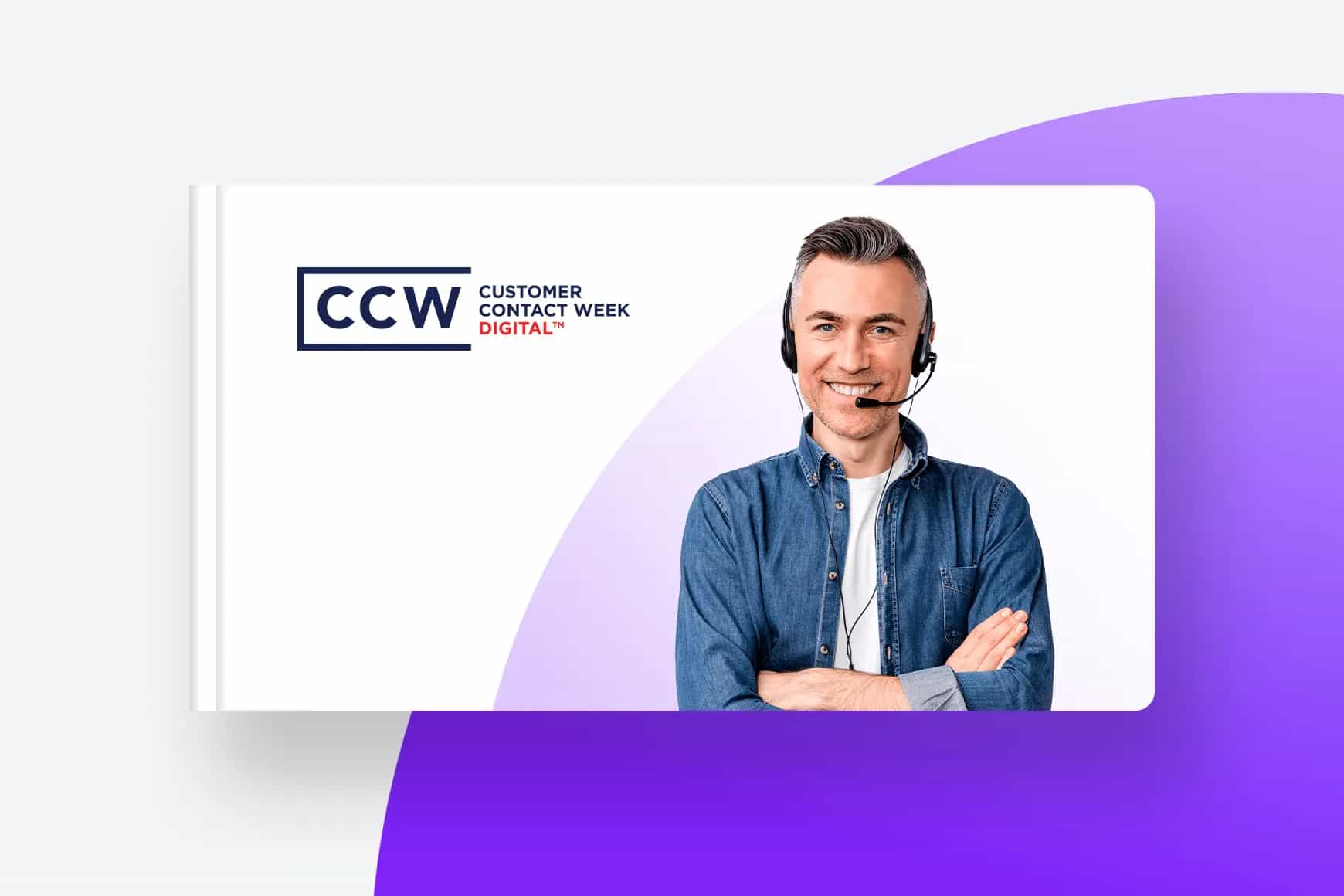The ultimate guide to contact center workforce management using AI

By Celia Cerdeira
0 min read

One of the biggest challenges of a contact center manager is workforce management. Not because people are difficult to manage, but because so many external factors have to be considered that, in the end, it seems much more like guesswork.
But that doesn’t have to be the case. Contact center workforce management greatly impacts contact center performance indicators, such as customer satisfaction and service level. And hitting those indicators takes much more than just assigning shifts—workforce management builds the foundation of a smooth-running contact center, and it can make a big difference if it’s done with the most appropriate tools.
In this blog, we look at the impact of workforce management software in the success of the contact center.
The building blocks of contact center workforce management.
Contact center workforce management includes four parts: forecasting, scheduling, assigning agents, and managing intraday activity. To understand the benefits of having a dedicated contact center workforce management system, you need to understand what each part involves.
Forecasting.
Forecasting includes estimating future query volume and the number of agents needed to handle those queries. Contact center forecasting predicts staff needs with reduced effort and a low error rate, maintaining a high level of service, and ensuring your customer satisfaction rate doesn’t drop.
Forecasting uses historical data—information about seasonal spikes, volume trends, and year-over-year changes that may affect the number of agents needed.
Scheduling.
The next step is to find the perfect balance between the number of available agents and the data provided by forecasts to determine shifts and hours of coverage. With an accurate prevision of future contact center demands, supervisors need to look to the skills of each agent, the contract work rules, and the calendar items to optimize the schedules.
Assigning agents.
This is the most delicate part of the process. Managers and supervisors want their teams to productive without getting overwhelmed. To ensure agents remain engaged and motivated, supervisors usually take into account the level of expertise, length of service, and performance when assigning agents to a specific shift.
Intraday management.
A lot can happen from the moment the supervisor assigns shifts. Contact centers are fast-paced environments with unexpected events (like sick leaves or sudden spikes of volume). Contact center supervisors and managers should be able to easily realign shifts and schedules to meet service levels.
The impact of contact center workforce management.
Other than saving contact center supervisors’ time, is there any other advantage of using workforce management software? Undoubtedly yes. Workforce management has a great impact on:
Agent engagement.
It’s not a difficult equation: happy agents make happy customers. Employees who are motivated and engaged create better experiences for customers. While this is not easy to translate directly to the bottom line, you’ll see the negative effects of distressed, unhappy employees in the long run. Workforce management software allows supervisors to leverage performance data to give better feedback, optimize training, and engage agents with metrics so they feel motivated to perform better.
Customer satisfaction.
Customers don’t care if you’re understaffed. They just want quick, efficient resolution without being put on hold or having to wait for long. Having the right agents available at the right moment is crucial to hitting targets in customer satisfaction scores (CSAT) and providing a superior customer experience.

REPORT
2023 CX Market Study: Opportunities, Trends, and Challenges
Customer experiences are regressing, with brands continuing to miss the mark in areas like personalization, speed, convenience, empathy, and channel accommodation. See what improvements brands need to make to elevate CX and customer satisfaction.
Operational efficiency.
Access to data is fundamental to making better business decisions. With the insights taken from the workforce management platform, managers can better respond to business targets without compromising customer and employee engagement.
Budget management.
If managers don’t know how many agents they’ll need for a certain period, they’ll under- or overestimate it. While understaffing damages customer satisfaction and the company’s reputation, overstaffing will increase significantly your payroll expenses.
Features of a contact center workforce management platform.
From a technical perspective, these are the features you should look for when considering a workforce management platform:
- Intelligent forecasting. Platforms powered by artificial intelligence (AI) help you generate forecasts based on historical and real-time data.
- Analytics and insights. The ability to create customizable dashboards and reports helps you analyze key performance metrics and make better business decisions.
- Automated scheduling. Choose a platform that allows you to automate and optimize the scheduling process based on shift templates, break rules, agent skills, and KPI goals.
- Adherence monitoring. Accurately monitor and compare actual agent behavior with scheduled activities.
- Omnichannel support. Generate forecasts and schedules that support your omnichannel strategy.
- Customer intent analysis. Interaction analytics captures, transcribes, and analyzes interactions, giving you a comprehensive understanding of customer intent and trends. Leverage these insights to listen to conversations and take action to deliver high-quality agent coaching to improve customer agent interactions.
- Automatic interaction scoring. Quality management software allows you to automatically score interactions, taking the guesswork out of performance evaluation.
- Security monitoring. Monitor agents for potential security threats, ensuring your customer information stays safe. Proactively identifying and addressing security risks ensures you not only protect your customers but also strengthen their trust in your brand.
Looking for a contact center workforce management solution?
Talkdesk Workforce Management™ combines powerful AI and automation with a remarkably intuitive user experience to help you optimize staffing and scheduling decisions, reduce administrative effort, and deliver a better experience for agents. See it for yourself in this detailed overview and watch the video demo.

ON DEMAND WEBINAR
Achieve greater operational flexibility and efficiency through workforce engagement management
Our workforce engagement experts will show you how to manage, develop, and retain high-performing agents by creating a streamlined agent experience that facilitates productivity, performance, and improved CSAT.
FAQs.
What is contact center workforce management?
Contact center workforce management refers to the way companies organize and manage employees and their workload. It’s like solving a puzzle, in which all the pieces have to fit together and even the smallest gaps can be significant.
There are plenty of workforce management software solutions available to help contact center managers do this without a hitch, ensuring the contact center team is staffed appropriately to meet demands.
Workforce management refers to the task of assigning the right number of agents at the right time to handle interactions. It includes managing internal and external factors to be able to:
- Forecast staffing needs.
- Plan schedules.
- Manage employee’s time.
- Manage contact center’s budget.
- Monitor and analyze results.
Are spreadsheets effective for workforce management in contact centers?
Using spreadsheets to manage contact center staff is a highly failable method and we do not recommend it. Managing a contact center and its staff means taking into consideration things like work legislation, local agreements, and budgets as well as agent’s contracts, skills, and availability. The number of combinations is too large to manage within a spreadsheet, not to mention how time-consuming it is.
How does AI impact contact center workforce management?
AI platforms can analyze vast quantities of data to generate accurate forecasts, automate scheduling, and provide real-time insights. This allows managers to make informed decisions quickly, improving operational efficiency.
Why is workforce management important for contact centers?
Workforce management is the backbone of any successful contact center. It ensures the right number of agents with the right skills are available at the right time to meet customer demands. This not only improves service levels but also reduces costs by minimizing overstaffing or understaffing.
Effective workforce management also boosts employee morale and productivity. Creating balanced schedules and providing agents with the tools they need to succeed fosters a positive work environment and reduces turnover rates.
Workforce management also allows for tracking of key performance metrics, giving insights into areas for improvement. This data-driven approach can drive continuous improvement, leading to enhanced customer satisfaction and business growth.
Why opt for a third-party workforce management platform?
It’s pretty much up to each organization. But there are some factors to consider if you’re not sure about an in-house workforce management solution or a third-party software:
- How many employees have to be registered, what is the extent of functionalities, and how many registration devices do you need?
- Which processes and tasks are expected to be handled through the workforce management solution?
- How would the workforce management platform integrate with the existing systems?
- Which type of vendor do you prefer: best of breed or a vendor with a broad suite of products?





